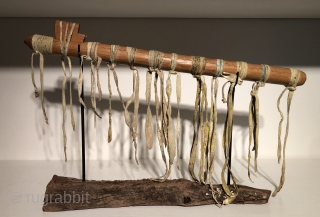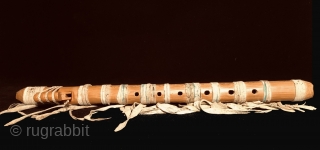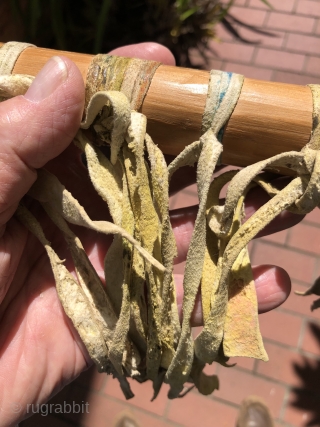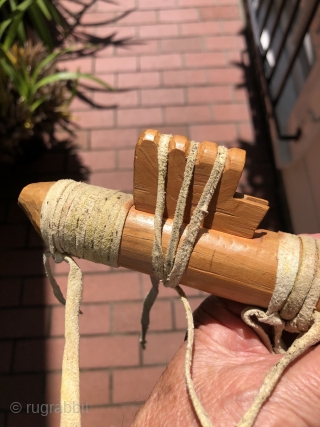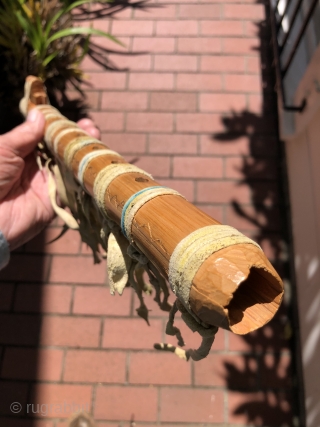Back
Native American flute. Plains tribes, probably Kiowa. Late 19th century or early 20th century. It still plays with a beautiful authentic sound. Playability is rare for truly old native American flutes. When found they are usually dry, cracked or warped with age. This flute is carved from a light colored, soft wood possibly pine and has original brain tanned deer hide ties tinted using a natural yellow pigment and a blue/green substance rubbed in to the deer hide strips. The unusual shape of the "fetish" - the carved wooden piece tied to the flute that directs the air stream over the splitting edge to create the sound - resembles a covered wagon, but this is speculative. For anyone interested in native american musical instruments this is a playable museum quality example. i have recorded with it and will supply a recording upon request. There is a truly haunting and timeless quality to the sound. This flute is a treasure worth having for the right person and comes with a handmade stand of weathered madrone wood for display purposes. See attached two old similar type flutes from u.s. museum collections.
price:
Inquire
- Home
- Antique Rugs by Region
- Category
- Profiles
- Post Items Free
- Albums
- Benaki Museum of Islamic Art
- Budapest: Ottoman Carpets
- Gulbenkian Museum
- Islamic Carpets. Brooklyn
- Islamic Textiles. Brooklyn
- Konya Museum: Rugs
- MKG, Hamburg
- MMA: Caucasian Carpets
- MMA: Mamluk Carpets
- MMA: Mughal Indian Carpets
- MMA: Ottoman Carpets
- MMA: Safavid Persian Carpets
- MMA: Turkmen Rugs
- McCoy Jones Kilims
- Ottoman textiles. Met
- Philadelphia Museum
- Rugs and Carpets: Berlin
- Seljuqs at the Met
- TIEM, Istanbul: Carpets
- V&A: Classical Carpets
- Vakiflar Carpets: Istanbul
- Baluch Rugs: Indianapolis
- Gallery Exhibitions
- Jaf an Exhibition
- Alberto Levi Gallery
- Andean Textile
- Christie's London: 2016
- Francesca Galloway
- HALI at 40
- ICOC Washington, DC 2018
- Jajims of the Shahsavan
- London Islamic Week April, 2018
- Mongolian Felts
- Navajo Rugs: JB Moore
- Persian Piled Weavings
- SF Tribal & Textile Art Show 2020
- SF Tribal 2019
- Sotheby's: C. Alexander
- Turkish Prayer Rugs
- Turkmen Main Carpets ICOC 2007









